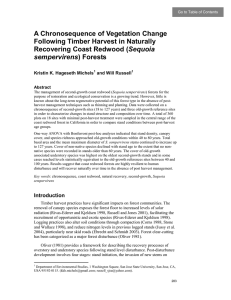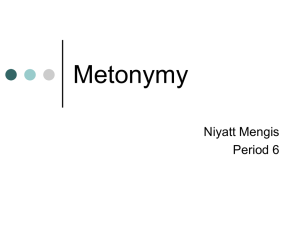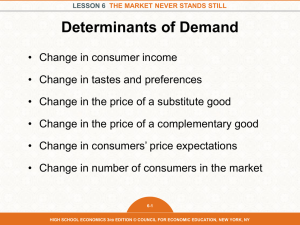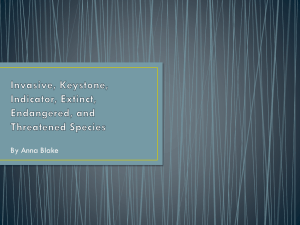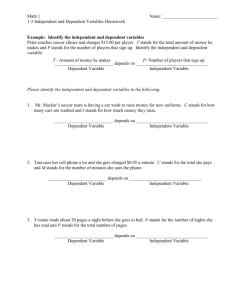(Sequoia sempervirens) forests - UC Agriculture and Natural
advertisement
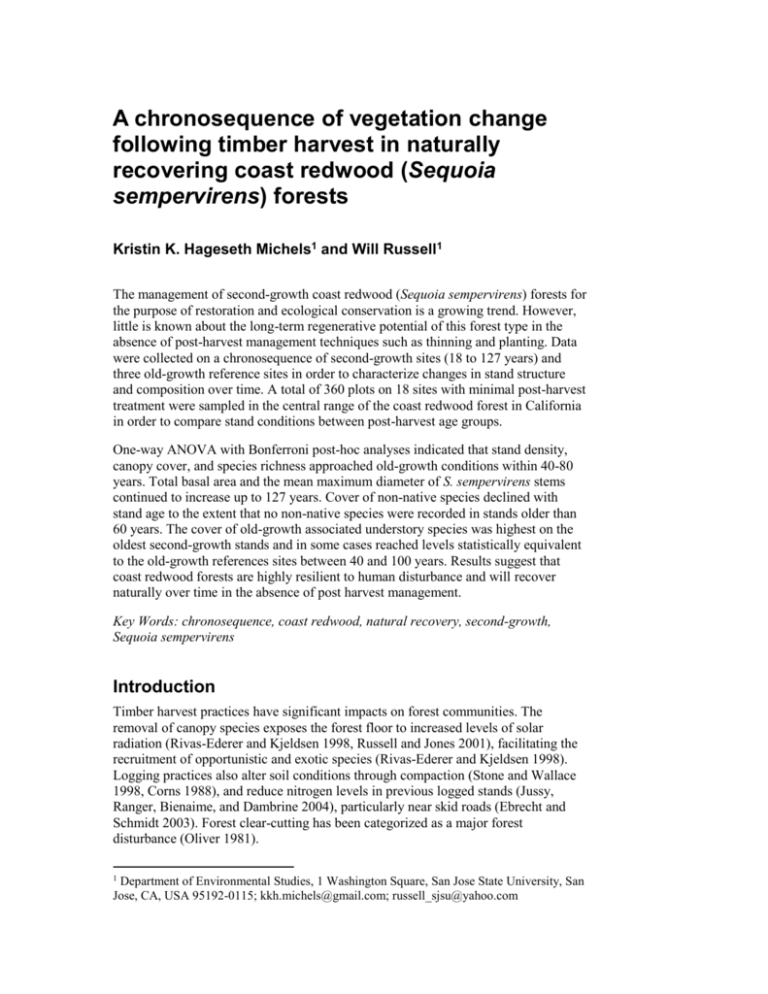
A chronosequence of vegetation change following timber harvest in naturally recovering coast redwood (Sequoia sempervirens) forests Kristin K. Hageseth Michels1 and Will Russell1 The management of second-growth coast redwood (Sequoia sempervirens) forests for the purpose of restoration and ecological conservation is a growing trend. However, little is known about the long-term regenerative potential of this forest type in the absence of post-harvest management techniques such as thinning and planting. Data were collected on a chronosequence of second-growth sites (18 to 127 years) and three old-growth reference sites in order to characterize changes in stand structure and composition over time. A total of 360 plots on 18 sites with minimal post-harvest treatment were sampled in the central range of the coast redwood forest in California in order to compare stand conditions between post-harvest age groups. One-way ANOVA with Bonferroni post-hoc analyses indicated that stand density, canopy cover, and species richness approached old-growth conditions within 40-80 years. Total basal area and the mean maximum diameter of S. sempervirens stems continued to increase up to 127 years. Cover of non-native species declined with stand age to the extent that no non-native species were recorded in stands older than 60 years. The cover of old-growth associated understory species was highest on the oldest second-growth stands and in some cases reached levels statistically equivalent to the old-growth references sites between 40 and 100 years. Results suggest that coast redwood forests are highly resilient to human disturbance and will recover naturally over time in the absence of post harvest management. Key Words: chronosequence, coast redwood, natural recovery, second-growth, Sequoia sempervirens Introduction Timber harvest practices have significant impacts on forest communities. The removal of canopy species exposes the forest floor to increased levels of solar radiation (Rivas-Ederer and Kjeldsen 1998, Russell and Jones 2001), facilitating the recruitment of opportunistic and exotic species (Rivas-Ederer and Kjeldsen 1998). Logging practices also alter soil conditions through compaction (Stone and Wallace 1998, Corns 1988), and reduce nitrogen levels in previous logged stands (Jussy, Ranger, Bienaime, and Dambrine 2004), particularly near skid roads (Ebrecht and Schmidt 2003). Forest clear-cutting has been categorized as a major forest disturbance (Oliver 1981). 1 Department of Environmental Studies, 1 Washington Square, San Jose State University, San Jose, CA, USA 95192-0115; kkh.michels@gmail.com; russell_sjsu@yahoo.com GENERAL TECHNICAL REPORT PSW-GTR-19x Oliver (1981) provides a framework for describing the recovery processes of overstory and understory species following stand level disturbance. Post-disturbance development involves four stages: stand initiation, the invasion of new stems on released sites; stem exclusion, the vertical stratification and competition among existing and new stems; understory reinitiation, the development of favorable conditions for understory species; and old-growth development, the increase in canopy variability and understory development (Oliver 1981). These processes have rarely been studied in naturally recovering understory and overstory vegetative communities in coast redwood (Sequoia sempervirens (D. Don) Endl.) forests after clear-cut harvest. The purpose of this study was to determine how coast redwood communities respond to this major disturbance over time. Methods This study was conducted in the central range of the coast redwood forest. Study sites were primarily located in the Big River watershed, consisting of more than 2,968 hectares of regenerating coast redwood forest (California Department of Parks and Recreation 2006) in Mendocino County, California. Much of the Big River watershed was managed as industrial timberland prior to its purchase by the Mendocino Land Trust in 2002, and was subsequently transferred to the California State Park system as the Big River Unit of Mendocino Headlands State Park (fig. 1). The Big River watershed was an ideal location for this study due to the presence of recovering redwood stands between 15 and 127 years old that had received minimal post-harvest manipulation. Three unharvested old-growth reference sites, the only sizable remaining old growth stands in Mendocino County, were also included in this study: the 49-hectare Russell Unit (the largest remaining old-growth redwood stand on the Mendocino coast), Montgomery Woods State Natural Reserve (462 hectares), and Hendy Woods State Park (342 hectares). Within the three study sites selected in each of the five post-harvest age classes (0 to 20, 21 to 40, 41 to 60, 81 to 100, and 101 to 130 years) and the three unharvested old-growth reference sites, 60 plots were sampled in each site (360 plots total). Sites were selected using detailed timber harvest and land management history data on a GIS platform (Rutland 2002). Site selection criteria included stands that were dominated by Sequoia sempervirens, previously clear-cut, large enough for adequate sampling without edge effects (Russell and Jones 2001), and received no post-harvest management such as seeding, thinning, or planting. The post-harvest age class of 61 to 80 years was not sampled as no sites in that age range existed that met these criteria. Physical variation between sites was minimized to the extent possible. Twenty, 20-meter (m) diameter (0.031 hectare), circular sample plots were randomly selected within each of the 18 study sites using ArcGISTM, and located using a handheld GPS receiver. Each sample plot was located a minimum of 20 m from adjacent plots, 10 m from special habitats such as riparian areas and rock outcroppings, and 200 m from adjacent age class boundaries and main access roads. Plot size and sampling intensity were determined through a pilot study using the species-area curve method (Cain 1938). Data were collected on each plot to describe the composition and structure of the existing stand as well as physical characteristics of the site. Slope, aspect, dominant canopy species, and percent canopy cover (measured with a spherical crown densiometer) were recorded at the center of each Title of the document plot. The occurrence and abundance of each tree species was recorded within each 20 m-diameter sample plot, as well as the diameter at breast height (dbh) of all individuals greater than 1 m in height. Percent cover was determined for all understory species using ocular estimates. All tree species and understory species were identified following nomenclature from the Jepson Manual (Hickman 1993). Statistical analyses were conducted in AabelTM. One-Way ANOVA were used to test differences between recovering stands and old-growth sites. Data were tested for normality using a skewness test and transformed using the natural log (loge) transformation if skewed. Additional post-hoc analyses were conducted using the Bonferroni test for pair-wise differences between groups. Results Tree species development Stand structure and composition varied significantly between age-classes. One-Way ANOVA indicated that tree density (F(5, 360)=27.599, p<0.001) (fig. 1a) and richness of tree species (F(5, 360)=17.121, p<0.001) (fig. 1b) declined significantly from younger to older stands, but did not statistically differ from old growth stands (hereafter referred to as ‘old-growth equivalence’) at 41 to 60 years after disturbance. Approaching levels of old-growth density and richness within 41 to 60 years suggests stands of this age class have successfully reached the stem exclusion phase of stand recovery as described by Oliver (1981). Canopy cover exhibited an inverse pattern than that of tree density and tree richness, as percent canopy cover increased across age classes (F(5, 360)=8.470, p<0.001) (fig. 1c). Canopy cover did not reach old-growth equivalence until stands were 81 to 100 years old. Although there was a significant increase over time, percent canopy cover exhibited minimal variation between age classes, ranging from approximately 76 percent in the youngest age class to approximately 86 percent in the old-growth stands. These results illustrate a dominant canopy is present throughout all stages of post-disturbance development in this ecosystem. a b Figure 1–One-Way ANOVA between (a) tree density (stems per hectare), (b) tree richness, (c) canopy cover, and age class with Bonferroni post hoc analyses in recovering and old-growth stands. c GENERAL TECHNICAL REPORT PSW-GTR-19x Similar to canopy cover, the combined basal area of all tree species (F(5, 360)=167.158, p<0.001) and the basal area of the most dominant tree species, Sequoia sempervirens (F(5, 360)=81.207, p<0.001), increased significantly with stand age (fig. 2a). Old-growth stands encompassed the highest combined basal area than any other age group. In contrast to canopy cover, however, total basal area and S. sempervirens basal area did not resemble areas typical of old-growth stands within the chronosequence of stands sampled. Observation of this pattern of development is limited by the ages of recovering stands sampled in the chronosequence (15 and 127 years) compared to the old-growth stands (>1,500 years). Although total basal area and S. sempervirens basal area did not statistically reach old-growth stands, basal area consistently increased throughout recovering stands and illustrated initial movement towards old-growth levels at 81 to 100 years. Basal area development, also indicated movement through the stem exclusion phase of recovery. The variability in dominance among the three most predominant tree species, Notholithocarpus densiflorus (Hook. & Arn.) Rehder, Ptseudotsuga menziesii (Mirb.) Franco var. menziesii, and Sequoia sempervirens, fluctuated throughout the chronosequence and compared to old-growth stands (fig. 2b). Both N. densiflorus and P. menziesii var. menziesii were dominant in the younger sites, however after stands reached 41 to 60 years, this variability in dominance decreased, favoring S. sempervirens in the older age classes. Due to the regenerative capability and growth pattern of S. sempervirens, the older sites and old-growth stands exhibited higher levels of dominance by this critical old-growth species and less variability in canopy dominance. a b Figure 2–(a) One-Way ANOVA between total dominance and age class in recovering and old-growth forests and Sequoia sempervirens dominance and age class in recovering and old-growth forests and (b) number of plots dominated by the three most dominant tree species, Notholithocarpus densiflorus, Ptseudotsuga menziesii, and Sequoia sempervirens, with Bonferroni post hoc analyses in each recovering age class and old-growth forests. Understory species development The understory community also significantly varied with stand age. Percent cover of understory species initially decreased immediately after harvest, reaching the lowest cover within 41 to 60 years, followed by a slight increase (F(5, 360)=52.140, p<0.001), illustrating a moderate bimodal pattern of development (fig. 3a). Understory dominance was closest to old-growth levels immediately after harvest, likely due to non-native species that easily colonize recently disturbed habitats. Understory percent cover did not achieve old-growth equivalence in the recovering stands. However, a subsequent increase of understory cover did occur in Title of the document the 81 to 100 year age group, suggesting the understory reinitiation phase may be suitable after at least 80 years of recovery. In contrast, the richness of understory species declined to old-growth levels after only a few decades of post-harvest recovery (F(5, 360)=4.261, p<0.001) (fig. 3b). As soon as 21 to 40 years after harvest, total understory species richness reached levels equivalent to old-growth stands. Compared to tree species richness, recovery of understory species richness progressed much quicker. Understory species richness achieved old-growth equivalence after at least 21 years of development, supporting the understory reinitiation that arises in subsequent age classes. a b Figure 3–One-Way ANOVA between (a) understory species percent cover, (b) understory species richness, and age class with Bonferroni post hoc analyses in recovering and old-growth forests. The recovery of individual associated understory species varied. The most dominant species in all age classes including old-growth, Oxalis oregana Nutt., steadily increased in second-growth stands, exhibiting the highest value within the recovering stands in the 101-130 age group, but did not statistically reach old-growth values (F(5, 360)=11.937, p<0.001) (fig. 4a). Although O. oregana did not statistically indicate full recovery during the chronosequence, maximum cover values approached old-growth within 101 to 130 years (fig. 4b). a b Figure 4–(a) One-Way ANOVA between Oxalis oregana percent cover and age class in recovering and old-growth forests and (b) maximum, minimum, and median values for O. oregana percent cover with Bonferroni post hoc analyses in each recovering age class and old-growth forests. Trillium ovatum Pursh increased significantly from the youngest to the oldest age-classes (F(5, 360)=16.247, p<0.001) (fig. 5a). T. ovatum achieved old-growth GENERAL TECHNICAL REPORT PSW-GTR-19x equivalence during the 81 to 100 age class. Although a decrease subsequently occurred, this may in part be due to an increase in O. oregana dominance. Non-native species cover was significantly higher in younger recovering stands compared to older age classes (F(5, 360)=16.328, p<0.001) (fig. 5b) and achieved old-growth equivalence in 81 to 100 years. Although exotic species were present in early age groups following harvest, non-native species were completely absent in second-growth stands older than 60 years and old-growth stands. a b Figure 5–One-Way ANOVA between (a) Trillium ovatum percent cover, (b) exotic species percent cover, and age class with Bonferroni post hoc analyses in recovering and old-growth forests. Discussion Results from the unmanaged stands sampled may be described utilizing the Oliver (1981) recovery model following major stand-scale disturbances. Stand characteristics including tree species density, tree species richness, S. sempervirens basal area, and total combined basal area of all tree species indicate the stem exclusion phase was reached within 41 to 80 years, supporting understory species richness to approach old-growth status shortly after disturbance. Development during this phase allowed for further understory reinitiation within 81 to 130 years as illustrated by the increased cover of native redwood associate species, including Trillium ovatum and Oxalis oregana, and die out of non-native species. Understory development continued in the oldest age class demonstrated by the marked increase in cover and dominance of O. oregana, the most prevalent understory species in all age classes. In this study, indicators of stand heterogeneity, such as tree species richness, were highest immediately after harvest, but declined in subsequent age groups, most likely due to the increased availability of resources immediately after harvest, such as greater soil fertility, solar radiation, and habitable landscapes (Tilman 1985, Fraterrigo et al. 2006). Fritz (1945) found that total tree density decreased after harvest within a permanently established naturally-recovering one-acre sample plot. Busing and Fujimori (2002, 2005) also illustrated high levels of S. sempervirens dominance in old-growth forests, which resulted in a decrease of tree species richness and diversity in stands. This research illustrates that tree species density and tree species richness are capable of stem exclusion, successfully reaching old-growth levels, without any active management of stands. Title of the document Increased basal area is characteristic of old-growth forests (Busing and Fujimori 2002, 2005) and can be attributed to the dramatic growth of the dominant species, S. sempervirens (Fritz 1945). As has been found in previous research, S. sempervirens in old-growth stands had the highest basal area (Busing and Fujimori 2002, 2005; Fujimori 1977; Russell and Jones 2001). In this study, basal area development of S. sempervirens contributed to the stem exclusion of other dominant tree species. Due to the regenerative capability, growth pattern, and longevity of S. sempervirens, additional time may be necessary for basal area to fully resemble oldgrowth levels in naturally recovering redwood communities. However, the older sites and old-growth stands exhibited higher levels of dominance by principal old-growth species, resulting in the understory initiation phase described by Oliver (1981). Old-growth forests exhibited the highest levels of canopy cover, but remained isolated to patches, due to an increase in canopy complexity and insularity (Loya and Jules 2007). Although younger stands were highest in tree density, the intermediate stages illustrated old-growth levels of canopy cover. This suggests that canopy cover began to move toward old-growth levels in the intermediate stages of recovery, allowing for understory development to take place. These developing stages produced similar levels of understory species as old-growth forests. As with density, the cover of these naturally recovering stands approached that of old-growth stands without active management. Future research should consider the effect of actively removing canopy species within these redwood communities and the subsequent effect on the development of native plant communities. Loya and Jules (2007) also found understory cover was highest in early stages of development following clearcut harvest, although the stem exclusion patterns occurring within the 41 to 80 year range in this study resulted in understory reinitiation and subsequent patch dominance of old-growth associate species, such as Oxalis oregana, in the 81 to 130 year stands. In addition, an important old-growth associate species, Trillium ovatum did reach old-growth equivalence during this understory reinitiation phase. Heavy soil compaction resulting from clear-cut harvest may not have allowed for adequate recovery of other understory species on the chronosequence sampled. Additional research, including soil analyses, is likely required to fully evaluate recovery patterns of understory species approaching oldgrowth levels. Although understory species richness was low in old-growth forests in this study and in previous research (Busing and Fujimori 2002, Loya and Jules 2007), richness reached old-growth equivalence within a relatively short time frame following disturbance. Richness of understory species was therefore also capable of recovery in second-growth stands without active management. In the unmanaged, naturally recovering redwood forest communities sampled, non-native species may establish in younger second-growth stands, but could eventually give way to native species over time. This supports previous research by Loya and Jules (2007) that also found few exotic species in old-growth stands. However, the year of introduction, life history, distribution, and physiology of exotic species must also be considered (Russell and Hageseth Michels 2010). Nonetheless, the most dominant exotic species within the study area, Cortaderia selloana (Schult. & Schult. f.) Asch. & Graebn. (pampas grass), was first introduced into California in 1848 (Lambrinos 2001), before the initial harvest of the oldest stands sampled. GENERAL TECHNICAL REPORT PSW-GTR-19x Recommendations The results of this study illustrate that a variety of community parameters and individual species followed Oliver’s (1981) model of natural forest recovery without active management. Even though sites were highly fragmented due to various harvest time frames and land use histories, older sites were relatively undisturbed, even from trail use or recreation activities, and existed in fairly remote areas distant from local populations. In addition, the Russell Unit is the least disturbed remaining old-growth stand on the Mendocino coast and is the most representative of old-growth communities of this region. These recovering stands have the potential to eventually resemble old-growth forests and retain developing old-growth characteristics. While the results from this study indicate that second-growth coast redwood stands are capable of natural recovery, some small-scale actions could enhance these stands. Continued presence or use of prominent logging roads would likely increase erosion, negatively affect edaphic health, and damage adjacent aquatic habitats. Major roads should be further decommissioned to a natural setting to mitigate potential negative effects. Due to the sensitivity of these stands, any recovery activities should take place with minimal impact. Limitations of this study could be clarified through additional research. This study focused on the vegetative change in redwood plant communities following clear-cut harvest on a chronosequence, although several other factors beyond the scope of this study likely contributed to the development of these forest communities. Future research on the stands sampled in this study could include assessing variables related to soil conditions, fungal associations, fauna biodiversity, or long-term vegetative monitoring. The recovering redwood stands of Mendocino County should continue as a focal point for forest ecologists. A detailed understanding of community development is necessary to manage recovering coast redwood forests. A management paradigm that focuses on specific tree species does not adequately assess timber harvest effects on the entire redwood community, which may hinder recovery. The remaining redwood forests are largely fragmented, increasing the importance of the overall continuity of the redwood range. If allowed sufficient time to recover after harvest, developing second-growth coast redwood communities could increasingly resemble old-growth redwood stands. Title of the document References Busing, Richard T.; Fujimori, Takao. 2002. Dynamics of composition and structure in an old Sequoia sempervirens forest. Vegetation Science 13: 785-792. Busing, Richard T.; Fujimori, Takao. 2005. Biomass, production and woody detritus in an old coast redwood (Sequoia sempervirens) forest. Plant Ecology 177: 177-188. Cain, Stanley A. 1938. The Species-Area Curve. American Midland Naturalist 19(3): 573581. California Department of Parks and Recreation. 2006. Draft Initial Study/Mitigated Negative Declaration. Big River Watershed Restoration, Mendocino Headlands State Park. Mendocino, CA. Cole, Dana W. 1983. Redwood sprout growth three decades after thinning. Journal of Forestry 81: 148-157. Corns, Ian G.W. 1988. Compaction by forestry equipment and effects on coniferous seedling growth on four soils in the Alberta foothills. Canadian Journal of Forest Research 18: 75-84. Ebrecht, Luis; Schmidt, Wolfgang. 2003. Nitrogen mineralization and vegetation along skidding tracks. Annals of Forest Science 60: 733-740. Fritz, Emanuel. 1945. Twenty years’ growth on a redwood sample plot. Journal of Forestry 43: 30-36. Hickman, James C. (ed.). 1993. The Jepson Manual of higher plants of California. Berkeley, CA: University of California Press. Lambrinos, John G. 2001. The expansion history of a sexual and asexual species of Cortaderia in California, USA. Ecology 89(1): 88-98. Lindquist, James L. 2004a. Precommercial stocking control of coast redwood: A seventeen year status report (1981-1998). California Forestry Report 2. Sacramento, CA: California Department of Forestry and Fire Protection; 25 p. Lindquist, James L. 2004b. Growth and yield report for the whiskey springs redwood commercial thinning study: A twenty-nine year status report (1970-1999). California Forestry Report 3. Sacramento, CA: California Department of Forestry and Fire Protection; 25 p. Loya, David T.; Jules, Erik S. 2007. Use of species richness estimators improves evaluation of understory plant response to logging: a study of redwood forests. Plant Ecology 194(2): 179-194. Jussy, Jean-Hughes; Ranger, Jacques; Bienaime, Severine; Dambrine, Etienne. 2004. Effects of a clear-cut on the in situ nitrogen mineralisation and the nitrogen cycle in a 67year-old Douglas-fir (Pseudotsuga menziesii (Mirb.) Franco) plantation. Annals of Forest Science 61: 397-405. Oliver, Chadwick D. 1981. Forest development in North America following major disturbances. Forest Ecology Management 3: 153-168. Oliver, William W.; Lindquist, James L.; Strothmann, Rudolph O. 1994. Young-growth redwood stands respond well to various thinning intensities. Western Journal of Applied Forestry 9(4): 106-112. Raven, Peter H. 1988. The California flora. In: Barbour, Michael G.; Major, Jack, editors. Terrestrial vegetation of California. 2nd ed. Sacramento, CA: California Plant Society Press; 109-137. GENERAL TECHNICAL REPORT PSW-GTR-19x Rivas-Ederer, Dina L.; Kjeldsen, Chris K. 1998. Seral vascular plant communities on clearcut sites in Jackson Demonstration State Forest, Mendocino County, California. Sonoma State University, California Department of Forestry and Fire Protection. Rohnert Park, CA. Russell, Will H.; Hageseth Michels, Kristin K. 2010. Stand Development on a 127-yr Chronosequence of Naturally Regenerating Sequoia sempervirens (Taxodiaceae) Forests. Madrono 57(4): 229-241. Russell, Will H.; Jones, Christine. 2001. The effects of timber harvesting on the structure and composition of adjacent old-growth coast redwood forest, California, USA. Landscape Ecology 16: 731-741. Rutland, Rob. 2002. Big River Land Use History, 1852-2001. Santa Rosa, CA: CalFire. Sawyer, John O.; Sillett, Stephen C.; Popenoe, James H.; LaBanca, Anthony; Sholars, Teresa; Largent, David L., et al. 2000. Characteristics of redwood forests. In: Noss, Reed F., editor. The redwood forest: History, ecology, and conservation of the coast redwoods. Washington D.C.: Island Press; 39-79. Stone, Michael K.; Wallace, J. Bruce. 1998. Long-term recovery of a mountain stream from clear-cut logging: the effects of forest succession on benthic invertebrate community structure. Freshwater Biology 39: 151-169.
